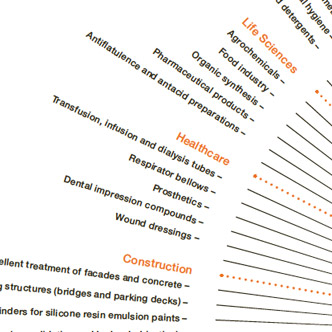18 Financial Instruments
The following table shows a presentation of financial assets and liabilities by measurement categories and classes. Also presented are liabilities from finance leases and derivatives that qualify for hedge accounting even though they do not belong to any of the IAS 39 measurement categories. WACKER has not pledged any financial assets as security.
The fair value of financial instruments measured at amortized cost is determined by means of discounting, taking into account market-participant interest rates that are adequate to the inherent risk and correspond to the relevant maturity. For reasons of immateriality, the carrying amount of current balance-sheet items is the same as their fair value.
Financial Assets and Liabilities by Measurement Category and Class as of Dec. 31, 2016
| Download XLS |
|
||||||||||||||
€ million |
|
Measurement pursuant to IAS 39 |
Measurement pursuant to IAS 17 |
|
||||||||||
|
Balance sheet carrying amount Dec. 31, 2016 |
(Amortized) cost |
Fair value through profit or loss |
Fair value through other comprehensive income |
(Amortized) cost |
Fair value Dec. 31, 2016 |
||||||||
|
|
|
|
|
|
|
||||||||
|
||||||||||||||
|
|
|
|
|
|
|
||||||||
Trade receivables |
775.7 |
775.7 |
– |
– |
– |
775.7 |
||||||||
Loans and receivables |
– |
775.7 |
– |
– |
– |
775.7 |
||||||||
Other financial assets |
176.6 |
170.5 |
2.9 |
3.2 |
– |
165.5 |
||||||||
Loans and receivables |
– |
159.4 |
– |
– |
– |
159.4 |
||||||||
Available-for-sale financial assets1 |
– |
11.1 |
– |
– |
– |
– |
||||||||
Derivatives that do not qualify for hedge accounting |
– |
– |
2.9 |
– |
– |
2.9 |
||||||||
Derivatives that qualify for hedge accounting |
– |
– |
– |
3.2 |
– |
3.2 |
||||||||
Securities and fixed-term deposits |
182.2 |
78.9 |
– |
103.3 |
– |
182.2 |
||||||||
Loans and receivables |
– |
78.9 |
– |
– |
– |
78.9 |
||||||||
Available-for-sale securities |
– |
– |
– |
103.3 |
– |
103.3 |
||||||||
Cash and cash equivalents |
283.5 |
283.5 |
– |
– |
– |
283.5 |
||||||||
Loans and receivables |
– |
283.5 |
– |
– |
– |
283.5 |
||||||||
Total financial assets |
1,418.0 |
– |
– |
– |
– |
1,406.9 |
||||||||
|
|
|
|
|
|
|
||||||||
Of which pursuant to IAS 39 measurement categories: |
|
|
|
|
|
|
||||||||
Loans and receivables |
1,104.8 |
1,104.8 |
– |
– |
– |
1,104.8 |
||||||||
Held-to-maturity securities |
192.7 |
192.7 |
– |
– |
– |
192.7 |
||||||||
Available-for-sale financial assets |
114.4 |
11.1 |
– |
103.3 |
– |
103.3 |
||||||||
Derivatives that do not qualify for hedge accounting |
2.9 |
– |
2.9 |
– |
– |
2.9 |
||||||||
Derivatives that qualify for hedge accounting |
3.2 |
– |
– |
3.2 |
– |
3.2 |
||||||||
|
|
|
|
|
|
|
||||||||
Financial liabilities (excluding finance leases) |
1,422.1 |
1,422.1 |
– |
– |
– |
1,419.5 |
||||||||
Measured at amortized cost |
– |
1,422.1 |
– |
– |
– |
1,419.5 |
||||||||
Liabilities from finance leases |
36.1 |
– |
– |
– |
36.1 |
36.1 |
||||||||
Trade payables |
369.7 |
369.7 |
– |
– |
– |
369.7 |
||||||||
Measured at amortized cost |
– |
369.7 |
– |
– |
– |
369.7 |
||||||||
Other financial liabilities |
64.1 |
35.4 |
17.4 |
11.3 |
– |
64.1 |
||||||||
Measured at amortized cost |
– |
35.4 |
– |
– |
– |
35.4 |
||||||||
Derivatives that do not qualify for hedge accounting |
– |
– |
4.3 |
– |
– |
4.3 |
||||||||
Derivatives that qualify for hedge accounting |
– |
– |
13.1 |
11.3 |
– |
24.4 |
||||||||
Total financial liabilities |
1,892.0 |
– |
– |
– |
– |
1,889.4 |
||||||||
|
|
|
|
|
|
|
||||||||
Of which pursuant to IAS 39 measurement categories: |
|
|
|
|
|
|
||||||||
Measured at amortized cost |
1,827.2 |
1,827.2 |
– |
– |
– |
1,824.6 |
||||||||
Derivatives that do not qualify for hedge accounting |
4.3 |
– |
4.3 |
– |
– |
4.3 |
||||||||
Derivatives that qualify for hedge accounting |
24.4 |
– |
13.1 |
11.3 |
– |
24.4 |
||||||||
|
|
|
|
|
|
|
||||||||
Financial Assets and Liabilities by Measurement Category and Class as of Dec. 31, 2015
| Download XLS |
|
||||||||||||||
€ million |
|
Measurement pursuant to IAS 39 |
Measurement pursuant to IAS 17 |
|
||||||||||
|
Balance sheet carrying amount Dec. 31, 2015 |
(Amortized) cost |
Fair value through profit or loss |
Fair value through other comprehensive income |
(Amortized) cost |
Fair value Dec. 31, 2015 |
||||||||
|
|
|
|
|
|
|
||||||||
|
||||||||||||||
|
|
|
|
|
|
|
||||||||
Trade receivables |
679.4 |
679.4 |
– |
– |
– |
679.4 |
||||||||
Loans and receivables |
– |
679.4 |
– |
– |
– |
679.4 |
||||||||
Other financial assets |
161.3 |
148.7 |
12.1 |
0.5 |
– |
150.2 |
||||||||
Loans and receivables |
– |
137.6 |
– |
– |
– |
137.6 |
||||||||
Available-for-sale financial assets1 |
– |
11.1 |
– |
– |
– |
– |
||||||||
Derivatives that do not qualify for hedge accounting |
– |
– |
11.2 |
– |
– |
11.2 |
||||||||
Derivatives that qualify for hedge accounting |
– |
– |
0.9 |
0.5 |
– |
1.4 |
||||||||
Securities and fixed-term deposits |
70.9 |
64.6 |
– |
6.3 |
– |
70.9 |
||||||||
Loans and receivables |
– |
64.6 |
– |
– |
– |
64.6 |
||||||||
Available-for-sale securities |
– |
– |
– |
6.3 |
– |
6.3 |
||||||||
Cash and cash equivalents |
310.5 |
310.5 |
– |
– |
– |
310.5 |
||||||||
Loans and receivables |
– |
310.5 |
– |
– |
– |
310.5 |
||||||||
Total financial assets |
1,222.1 |
– |
– |
– |
– |
1,211.0 |
||||||||
|
|
|
|
|
|
|
||||||||
Of which pursuant to IAS 39 measurement categories: |
|
|
|
|
|
|
||||||||
Loans and receivables |
1,033.3 |
1,033.3 |
– |
– |
– |
1,033.3 |
||||||||
Held-to-maturity securities |
158.8 |
158.8 |
– |
– |
– |
158.8 |
||||||||
Available-for-sale financial assets |
17.4 |
11.1 |
– |
6.3 |
– |
6.3 |
||||||||
Derivatives that do not qualify for hedge accounting |
11.2 |
– |
11.2 |
– |
– |
11.2 |
||||||||
Derivatives that qualify for hedge accounting |
1.4 |
– |
0.9 |
0.5 |
– |
1.4 |
||||||||
|
|
|
|
|
|
|
||||||||
Financial liabilities (excluding finance leases) |
1,416.3 |
1,416.3 |
– |
– |
– |
1,421.7 |
||||||||
Measured at amortized cost |
– |
1,416.3 |
– |
– |
– |
1,421.7 |
||||||||
Liabilities from finance leases |
39.1 |
– |
– |
– |
39.1 |
39.1 |
||||||||
Trade payables |
378.3 |
378.3 |
– |
– |
– |
378.3 |
||||||||
Measured at amortized cost |
– |
378.3 |
– |
– |
– |
378.3 |
||||||||
Other financial liabilities |
50.1 |
21.8 |
16.0 |
12.3 |
– |
50.1 |
||||||||
Measured at amortized cost |
– |
21.8 |
– |
– |
– |
21.8 |
||||||||
Derivatives that do not qualify for hedge accounting |
– |
– |
15.9 |
– |
– |
15.9 |
||||||||
Derivatives that qualify for hedge accounting |
– |
– |
0.1 |
12.3 |
– |
12.4 |
||||||||
Total financial liabilities |
1,883.8 |
– |
– |
– |
– |
1,889.2 |
||||||||
|
|
|
|
|
|
|
||||||||
Of which pursuant to IAS 39 measurement categories: |
|
|
|
|
|
|
||||||||
Measured at amortized cost |
1,816.4 |
1,816.4 |
– |
– |
– |
1,821.8 |
||||||||
Derivatives that do not qualify for hedge accounting |
15.9 |
– |
15.9 |
– |
– |
15.9 |
||||||||
Derivatives that qualify for hedge accounting |
12.4 |
– |
0.1 |
12.3 |
– |
12.4 |
||||||||
|
|
|
|
|
|
|
||||||||
The loans and receivables reported include trade receivables, other loans and fixed-term deposits as well as cash and cash equivalents. Cash and cash equivalents in foreign currency are measured at the conversion rate prevailing on the reporting date. Their carrying amounts correspond to their fair values. The fair value of the loans corresponds to their present value, i. e. the present value of the expected future cash flows. Discounting is carried out on the basis of the interest rates valid on the reporting date.
Available-for-sale financial assets include securities and investments in joint ventures and associates. Investments in joint ventures and associates are measured at cost, as no observable prices on active markets are available.
The carrying amounts of trade payables and other financial liabilities correspond to their fair values. The fair values of financial liabilities constitute the present value of the expected future cash flows. Discounting is carried out on the basis of the interest rates valid on the reporting date. All other financial liabilities are valued at cost as no observable prices for them are available.
The following table shows the net gains and losses from financial instruments.
| Download XLS |
|
|
|
||
€ million |
2016 |
2015 |
||
|
|
|
||
|
|
|
||
Net gains / losses from financial instruments |
|
|
||
Loans and receivables |
17.9 |
29.5 |
||
Available-for-sale financial assets |
1.3 |
0.7 |
||
Assets / liabilities classified as at fair value through profit or loss |
-15.9 |
7.5 |
||
Financial liabilities at amortized cost |
-46.3 |
-66.0 |
||
Total |
-43.0 |
-28.3 |
||
|
|
|
The net result of the category “Loans and receivables” was primarily due to net losses / gains from foreign currency translation, interest income from financial assets, demand deposits and valuation allowances.
The category “Available-for-sale financial assets” includes interest income from fixed-interest securities.
The category “Held-to-maturity financial assets” mainly comprises fixed-term deposits with terms of up to one year that are posted under securities.
The gains and losses from changes in the fair value of foreign-currency exchange rates, interest rates and commodity derivatives that do not fulfill the requirements of IAS 39 for hedge accounting are posted in the category “Assets / liabilities classified as at fair value through profit or loss.” The effects of fair value hedge accounting are also reported here.
The interest income from financial assets that are not recognized at fair value through profit or loss amounted to €5.6 million, compared with the prior-year figure of €6.9 million. This interest income mainly results from demand deposits and loans as well as from held-to-maturity securities.
The interest expense from financial liabilities that are not recognized at fair value through profit or loss amounts to €42.4 million, versus €31.8 million in the prior year. These interest expenses are mainly due to financial liabilities.
The net losses in the category “Financial liabilities measured at amortized cost” primarily consist of interest expenses on bank liabilities and other financial liabilities, as well as net losses / gains from foreign currency translation.
Neither in the year under review nor in the previous year were there any reclassifications of financial assets between those recognized at amortized cost and those recognized at market value or vice versa.
The financial assets and liabilities measured at fair value in the financial statements were allocated to one of three categories in accordance with the fair value hierarchy described in IFRS 13. Allocation to these categories reveals which of the fair values reported were settled through market transactions and the extent to which the measurement was based on models in the absence of observable market transactions.
The following are the levels of the hierarchy.
Level 1
Financial instruments measured using quoted prices in active markets, the fair value of which can be derived directly from prices in active liquid markets and for which the financial instrument observable in the market is representative of the financial instrument being measured. These include fixed-interest securities traded in liquid markets.
Level 2
Financial instruments measured using valuation methods based on observable market data, the fair value of which can be determined using similar financial instruments traded in active markets or using valuation methods all of whose parameters are observable. These include hedging and non-hedging derivative financial instruments, loans and financial liabilities.
Level 3
Financial instruments measured using valuation methods not based on observable parameters, the fair value of which cannot be determined using observable market data and which require application of different valuation methods. The financial instruments belonging to this category have a value component that is not market-observable and has a major impact on fair value. These include over-the-counter derivatives and unquoted equity instruments.
The following table shows the categories in the fair value hierarchy to which the financial assets and liabilities measured at fair value in the statement of financial position are allocated. The table also shows financial assets and liabilities measured at cost in the statement of financial position. Their fair values are given in the Notes:
Fair Value Hierarchy
| Download XLS |
|
|
|||||||
€ million |
Fair value hierarchy |
Total |
||||||
|
Level 1 |
Level 2 |
Level 3 |
|
||||
|
|
|
|
|
||||
|
|
|
|
|
||||
As of December 31, 2016 |
|
|
|
|
||||
Financial assets measured at fair value |
|
|
|
|
||||
Fair value through profit or loss |
|
|
|
|
||||
Derivatives that do not qualify for hedge accounting |
– |
2.9 |
– |
2.9 |
||||
Fair value through other comprehensive income / through profit or loss |
|
|
|
|
||||
Derivatives that qualify for hedge accounting |
– |
3.2 |
– |
3.2 |
||||
Available-for-sale securities and fixed-term deposits |
103.3 |
– |
– |
103.3 |
||||
Total |
103.3 |
6.1 |
– |
109.4 |
||||
|
|
|
|
|
||||
Financial assets measured at amortized cost |
|
|
|
|
||||
Loans and receivables |
|
|
|
|
||||
Loans |
– |
96.4 |
– |
96.4 |
||||
Total |
– |
96.4 |
– |
96.4 |
||||
|
|
|
|
|
||||
Financial liabilities measured at fair value |
|
|
|
|
||||
Fair value through profit or loss |
|
|
|
|
||||
Derivatives that do not qualify for hedge accounting |
– |
4.3 |
– |
4.3 |
||||
Fair value through other comprehensive income / through profit or loss |
|
|
|
|
||||
Derivatives that qualify for hedge accounting |
– |
24.4 |
– |
24.4 |
||||
Total |
– |
28.7 |
– |
28.7 |
||||
|
|
|
|
|
||||
Financial liabilities measured at amortized cost |
|
|
|
|
||||
Financial liabilities |
|
|
|
|
||||
Measured at amortized cost |
– |
1,419.5 |
– |
1,419.5 |
||||
Total |
– |
1,419.5 |
– |
1,419.5 |
||||
|
|
|
|
|
||||
Fair Value Hierarchy
| Download XLS |
|
|
|||||||
€ million |
Fair value hierarchy |
Total |
||||||
|
Level 1 |
Level 2 |
Level 3 |
|
||||
|
|
|
|
|
||||
|
|
|
|
|
||||
As of December 31, 2015 |
|
|
|
|
||||
Financial assets measured at fair value |
|
|
|
|
||||
Fair value through profit or loss |
|
|
|
|
||||
Derivatives that do not qualify for hedge accounting |
– |
11.2 |
– |
11.2 |
||||
Fair value through other comprehensive income / through profit or loss |
|
|
|
|
||||
Derivatives that qualify for hedge accounting |
– |
1.4 |
– |
1.4 |
||||
Available-for-sale securities and fixed-term deposits |
6.3 |
– |
– |
6.3 |
||||
Total |
6.3 |
12.6 |
– |
18.9 |
||||
|
|
|
|
|
||||
Financial assets measured at amortized cost |
|
|
|
|
||||
Loans and receivables |
|
|
|
|
||||
Loans |
– |
99.9 |
– |
99.9 |
||||
Total |
– |
99.9 |
– |
99.9 |
||||
|
|
|
|
|
||||
Financial liabilities measured at fair value |
|
|
|
|
||||
Fair value through profit or loss |
|
|
|
|
||||
Derivatives that do not qualify for hedge accounting |
– |
15.9 |
– |
15.9 |
||||
Fair value through other comprehensive income / through profit or loss |
|
|
|
|
||||
Derivatives that qualify for hedge accounting |
– |
12.4 |
– |
12.4 |
||||
Total |
– |
28.3 |
– |
28.3 |
||||
|
|
|
|
|
||||
Financial liabilities measured at amortized cost |
|
|
|
|
||||
Financial liabilities |
|
|
|
|
||||
Measured at amortized cost |
– |
1,421.7 |
– |
1,421.7 |
||||
Total |
– |
1,421.7 |
– |
1,421.7 |
||||
WACKER regularly reviews whether its financial instruments are still appropriately allocated to the fair-value-hierarchy levels. As was the case in the previous year, no reclassifications were carried out within the fair value hierarchy in 2016.
In the period under review, WACKER measured only financial assets and liabilities at fair value. The market values were calculated using market information available on the reporting date and based on counterparties’ quoted prices or via appropriate valuation methodologies (discounted cash-flow or well-established actuarial methodologies, such as the par method).
Derivative financial instruments and available-for-sale financial assets are recognized at fair value and are thus subject to a recurring fair-value assessment.
The fair value of derivative financial instruments is calculated based on market data such as exchange rates or yield curves in accordance with market-specific valuation methodologies. The calculation of the fair value contains our own and the counterparty’s default risk, using maturity-matching and market-observable CDS values. The fair value of available-for-sale financial assets can be derived from prices listed in active markets.
Loans and financial liabilities are measured at amortized cost. However, the fair values must be provided in the Notes.
The fair value of the loans corresponds to the present value of expected future cash flows. Application of the discounted cash flow method using market interest rates means that the carrying amount of the loans corresponds to their fair value.
The fair value of financial liabilities is determined using the net present value method and is based on standard market interest rates.
It was not possible to calculate the fair value of the equity instruments that WACKER measures at amortized cost as no stock market prices or market values are available. The instruments in question are shares in unlisted companies for which there was no indication of a lasting impairment on the reporting date and the fair value of which cannot reliably be determined. WACKER had no intention of selling any of the shares reported as of December 31, 2016.
The unilateral call option held by WACKER for the purchase of 1 percent of the shares in the subsidiary WACKER Asahikasei Silicones Co. Ltd., Japan is recognized at cost as of December 31, 2016.
WACKER does not currently have any financial instruments measured at fair value that are allocated to Level 3 of the fair value hierarchy.
No changes were made to the valuation methodology compared with the previous year.
Management of Financial Risks
In the normal course of business, WACKER is exposed to credit, liquidity, and market risks from financial instruments. The aim of financial risk management is to limit risks from operations and the resultant financing requirements by using certain derivative and non-derivative hedging instruments.
The risks connected with the procurement, financing and selling of WACKER’s products and services are described in detail in the management report. WACKER counters financial risks via the risk management system it has in place. That system is monitored by the Supervisory Board. The fundamental purpose of the risk management system is to identify, analyze, coordinate, monitor and communicate risks in a timely manner. The Executive Board receives regular analyses on the extent of those risks. The analyses focus on market risks, in particular on the potential impact of raw-material price risks, foreign-currency exchange risks, and interest rate risks on EBITDA and interest result.
Credit Risk (Risk of Default)
In terms of financial instruments, the Group is exposed to a default risk should a contractual party fail to fulfill its commitments. The maximum risk is therefore the amount of the respective financial instrument’s positive fair value. To limit the risk of default, particularly for investments of securities and cash, transactions are conducted only within defined limits and with partners of very high credit standing. To make efficient risk management possible, the market risks within the Group are controlled centrally. The conclusion and handling of transactions comply with internal credit-risk principles and are subject to monitoring procedures that take account of the separation of duties. As for operations, outstanding receivables and default risks are continually monitored and hedged with trade credit insurance, advance payments and bank guarantees. Customer credit ratings and limits are based on generally available information from rating agencies and internal documents. No collateral exists for financial instruments. Receivables from major customers are not so high as to represent an extraordinary concentration of risks. Default risks are accounted for by valuation allowances, taking advance payments received into account.
Liquidity Risk
A liquidity risk means that a company may not be able to meet its existing or future financial obligations due to inadequate funds. To ensure uninterrupted solvency and financial flexibility, the Group holds long-term lines of credit at financial institutions of high credit standing and liquid funds based on multiyear financial planning and rolling liquidity planning.
To limit liquidity risk, WACKER keeps liquid reserves in the form of current investments and unused lines of credit. WACKER has also concluded agreements with a number of banks for long-term syndicated loans and bilateral loans.
For information on the maturity analysis for non-derivative financial liabilities, please refer to the note on Financial Liabilities. See Note 13
Market Risks
Market risks refer to the risk that fair values or future cash flows of a primary or derivative financial instrument could fluctuate due to changing risk factors.
Foreign Exchange Risk
The potential currency exposure to be hedged with derivative financial instruments is determined on the basis of major foreign-currency income and expenditure. The greatest risk is posed by the US dollar. US-dollar income is taken to mean all sales invoiced in US dollars, while all purchases in US dollars as well as site costs incurred in US dollars are reported under US-dollar expenditure. The evaluation of potential risks includes not only direct US-dollar income and expenditure, but also the indirect US-dollar impact of WACKER’s main raw materials (methanol and natural gas). The US dollar is the only relevant risk variable for the sensitivity analysis in accordance with IFRS 7, since the largest share of foreign-currency cash flows is in US dollars. By comparison, increases in the euro exchange rate against the renminbi (CNY) and yen (JPY) have a minor impact. In determining sensitivity, we simulate a 10-percent US-dollar devaluation against the euro, taking as a starting point the exchange rate used in the forecast. Such a devaluation would have had an effect on EBITDA of €–58 million as of December 31, 2016 and of € –60 million as of December 31, 2015. The effect from cash-flow-hedge designated items would have increased equity before income taxes by €15.3 million, versus €29.4 million a year earlier. The Group’s currency exposure amounted to €582 million as of December 31, 2016, after €595 million in the prior year.
Interest Rate Risk
The interest rate risk results mainly from financial liabilities and interest-bearing investments. The Executive Board determines the mix of fixed- and variable-interest financial debt. Interest rate derivatives are concluded as required, taking account of the given structure. Depending on whether the instrument in question has a fixed or variable interest rate, the interest rate risks are measured on the basis of either market-value sensitivity or cash-flow sensitivity. As financial liabilities and fixed-interest investments are measured at amortized cost, they are, in accordance with IFRS 7, not subject to any interest-rate risk. Available-for-sale securities are recognized at fair value. Due to their short maturities, they are not subject to a significant risk of changes in interest rates. Hedge accounting is not used for any of the interest rate derivatives. Changes in market interest rates have an impact on the net interest income generated by variable-interest financial instruments and are thus included in the calculation of earnings-related sensitivity. Changes in the market interest rates of interest rate derivatives affect the financial result, and are consequently included in any earnings-related sensitivity analysis. If the market interest rate on December 31, 2016 had been 100 base points lower (December 31, 2015: lower), the interest result would have been €0.4 million (€1.4 million) lower (lower).
Raw-Material Price Risk
In general, the company is faced with the risk that its supplies of raw materials may be inadequate and that potential increases in raw-material prices could threaten its results. These risks are covered by long-term contracts. Cash flow hedge accounting is used only to a minor degree for long-term energy needs in Norway. This item is recognized in profit or loss under the cost of goods sold.
Derivative Financial Instruments
Financial risks are also hedged using derivative financial instruments. The raw-material price risks that WACKER hedges against result principally from ongoing energy procurement. Electricity-supply price hedging takes place via contractual stipulations, for which the “own-use exemption” rules of IAS 39 can essentially be used. These contracts, which are concluded for the purpose of receiving or delivering non-financial goods according to WACKER’s own needs, are not recognized as derivatives, but rather as pending transactions.
In those cases where WACKER hedges against currency risks, it uses derivative financial instruments, in particular currency forward exchange contracts, currency options and foreign exchange swaps. Derivatives are used only if they are backed by positions, cash deposits and funding, or scheduled transactions arising from operations. The scheduled transactions also include anticipated, but not yet invoiced, sales in foreign currencies.
Foreign exchange hedging is carried out particularly for the US dollar, Japanese yen and Singapore dollar. Potential interest rate hedges are based on the maturities of the underlying transactions.
Operational hedging in the foreign exchange area relates to the receivables and liabilities already recognized, and generally covers time horizons of between two and three months. The time horizon for strategic hedging is between three and a maximum of 21 months. The hedged cash flows influence the statement of income at the time when sales are realized. The cash inflows are usually recorded shortly afterward, depending on the payment deadline. As well as receivables from and liabilities to third parties, intercompany financial receivables and liabilities are hedged.
The fair values refer to the repurchase values (redemption values) of the financial derivatives as of the balance sheet date and are calculated using recognized actuarial methods.
The derivatives are recognized at their fair values, irrespective of their stated purpose. They are reported in the statement of financial position under other financial assets or other financial liabilities. Where permissible, cash flow hedge accounting is carried out for the strategic hedging of currency exchange risks from future foreign exchange positions. Depending on the nature of the underlying transaction, they are posted in the statement of income either under the operating result or, if financial liabilities are being hedged, under interest result or other financial result.
For strategic hedging purposes, graduated hedging ratios of between 50 and 30 percent are used in relation to the expected net exposure in US dollars. The expected net exposure for 2017 is about 50 percent hedged, with the expected additional net exposure for semiconductor business for 2018 being around 15 percent hedged. The average hedging ratio for operational hedging in US dollars is around 50 percent.
In fiscal 2016, the accumulated income and expenses recorded directly in equity included a pre-tax result from cash flow hedges amounting to €7.6 million, compared with €15.8 million in the prior year. During 2016, € –21.1 million was reclassified to the statement of income, after €69.7 million in the prior year. In the result for the period, no gains or losses from hedge accounting ineffectiveness were recorded, as the hedging relationships were almost entirely effective.
The purpose of fair value hedges is to hedge against changes in the fair value of financial assets and liabilities that come about because of fluctuations in the value of currencies (foreign currency swap). If the hedge is effective, the carrying amount of the corresponding underlying transaction is amended to reflect the changes in the fair value of the hedged risks. At year end, WACKER recognized income of €5.1 million from the valuation of the hedging instrument under fair value hedges, versus income of €7.3 million in the prior year. At the same time, an expense of € –5.1 million was realized on the underlying transaction, versus an expense of € –7.3 million a year earlier. Both amounts were recognized in the financial result. In the case of another fair value hedge, a loss of €3.2 million from measurement of the hedge and a gain of €3.2 million from measurement of the underlying transaction were recognized under other operating expenses.
| Download XLS |
|
|
|
||||||
€ million |
Dec. 31, 2016 |
Dec. 31, 2015 |
||||||
|
Nominal |
Market |
Nominal |
Market |
||||
|
|
|
|
|
||||
|
|
|
|
|||||
Foreign exchange derivatives |
1,637.2 |
-21.8 |
1,826.5 |
-12.7 |
||||
Other derivatives |
15.0 |
-0.8 |
17.3 |
-3.0 |
||||
Total |
1,652.2 |
-22.6 |
1,843.8 |
-15.7 |
||||
|
|
|
|
|
||||
Market values of derivative financial instruments used for hedge accounting |
|
-21.1 |
|
-11.3 |
||||
|
|
|
|
|||||
The foreign exchange derivatives mainly comprise forward exchange contracts, foreign exchange options and foreign exchange swaps amounting to US$ 610.8 million, ¥ 33.1 billion, SG$ 70.7 million and €687.0 million, versus US$ 1,309.5 million, ¥ 28.0 billion, SG$ 469.7 million and CHF 10.5 million a year earlier. Derivatives with market values of € –22.4 million are due in 2017, and €0.5 million expire in 2018.
Other derivatives involve electricity futures traded on the Norwegian market for a nominal amount of €15.0 million, after €17.3 million in the prior year. The electricity futures are used to limit the risk of rising spot-market prices for energy via structured price setting on the electricity market. The hedged amount represents up to 90 percent of the Holla (Norway) site’s future silicon-production power needs not covered by long-term supply contracts. The futures have maturities of between one and four years. Derivatives with maturities up until 2020 were concluded.
The following table contains information on the netting of financial assets and liabilities in the consolidated statement of financial position.
Financial Assets / Liabilities Subject to Netting Agreements, Enforceable Global Netting Agreements and Similar Agreements
| Download XLS |
|
|
|
||||||
€ million |
Dec. 31, 2016 |
Dec. 31, 2015 |
||||||
|
Derivatives with a positive market value |
Derivatives with a negative market value |
Derivatives with a positive market value |
Derivatives with a negative market value |
||||
|
|
|
|
|
||||
|
|
|
|
|||||
I |
|
|
|
|
||||
Gross amounts of recognized financial assets / liabilities |
7.4 |
-29.9 |
12.7 |
-28.4 |
||||
II |
|
|
|
|
||||
Gross amounts of recognized financial assets / liabilities netted out in the balance sheet |
-1.3 |
1.3 |
-0.1 |
0.1 |
||||
I + II |
|
|
|
|
||||
Net amounts of financial assets / liabilities presented in the balance sheet |
6.1 |
-28.6 |
12.6 |
-28.3 |
||||
|
|
|
|
|
||||
Related amounts not netted out in the balance sheet |
|
|
|
|
||||
Financial instruments |
-5.0 |
5.0 |
-6.1 |
6.1 |
||||
Cash collateral received / paid |
– |
– |
– |
– |
||||
|
|
|
|
|
||||
Net amount |
1.1 |
-23.6 |
6.5 |
-22.2 |
||||
|
|
|
|
|||||
In addition to the financial instruments complying with the provisions on netting pursuant to IAS 32, the table also includes those financial instruments that are subject to netting agreements or master netting agreements but may not be netted pursuant to IAS 32.
As a part of strategic hedging activities, WACKER closes out forward-exchange contracts prior to maturity by means of offsetting transactions. The strategic forward-exchange contract and the corresponding offsetting forward-exchange transaction are recognized as a net amount in accordance with IAS 32 criteria. In addition, general offsetting agreements, which apply only in cases of insolvency, have been concluded with a number of banks.
The net amount shows the amount of financial assets or liabilities that, despite netting and global netting agreements, is not received or must be paid in the event of insolvency.









